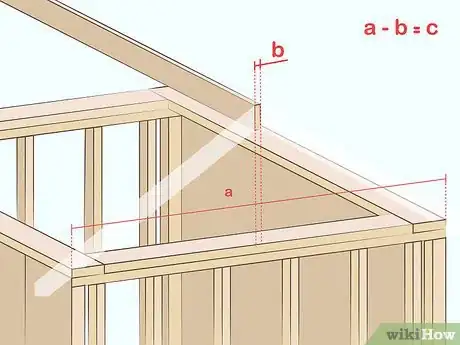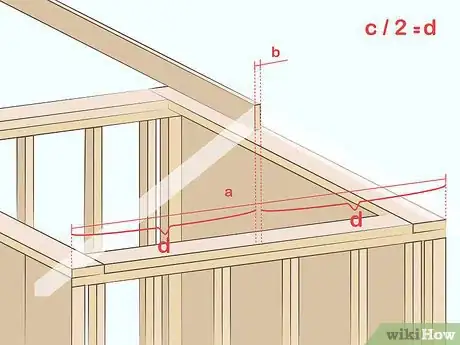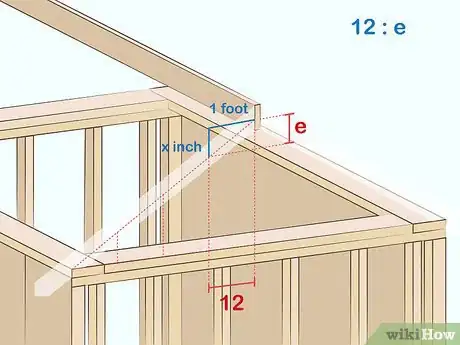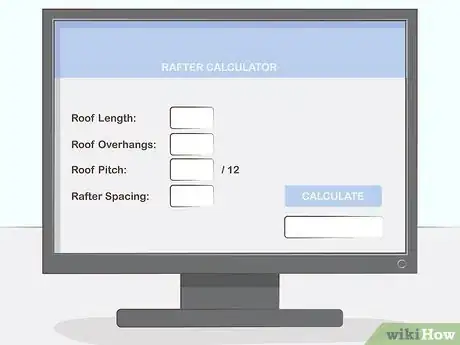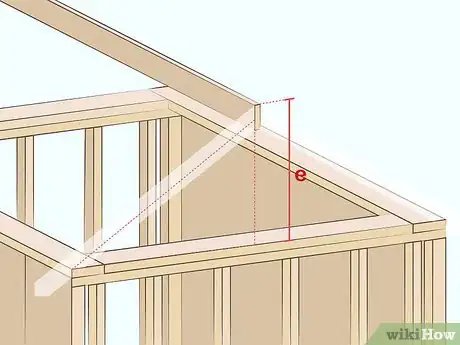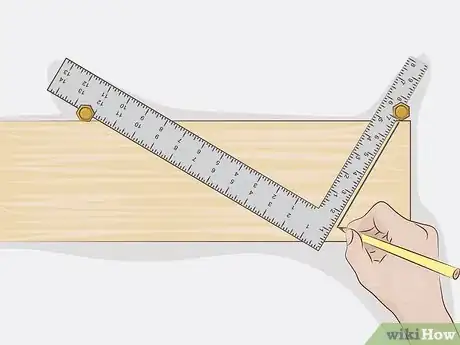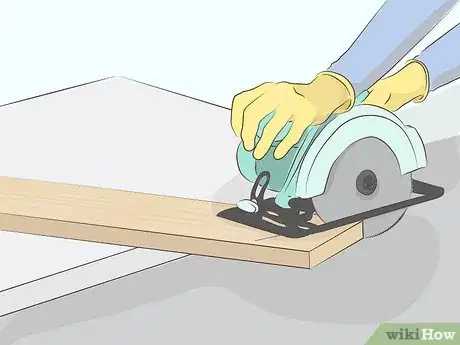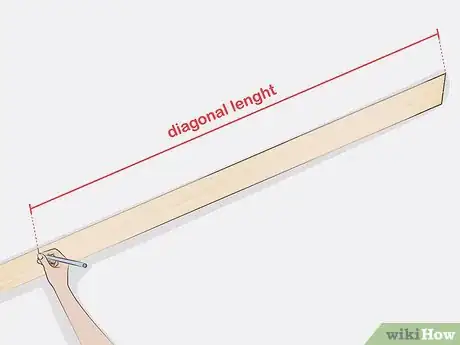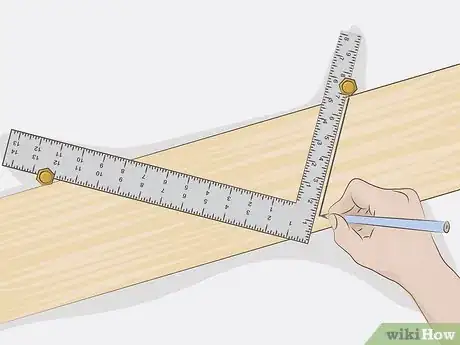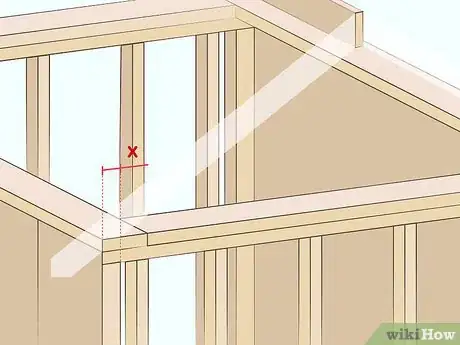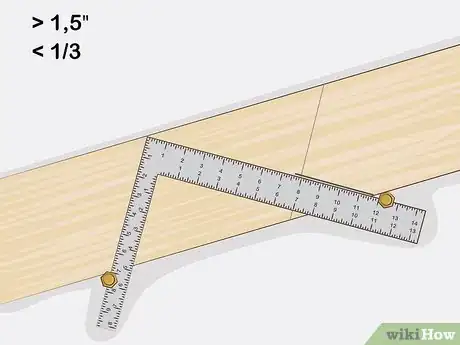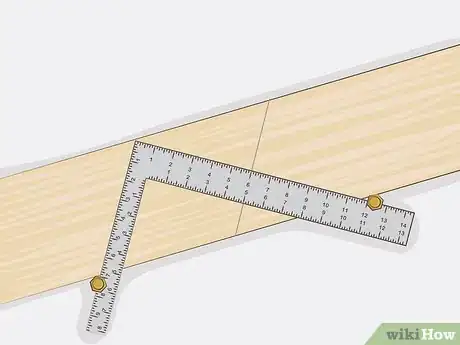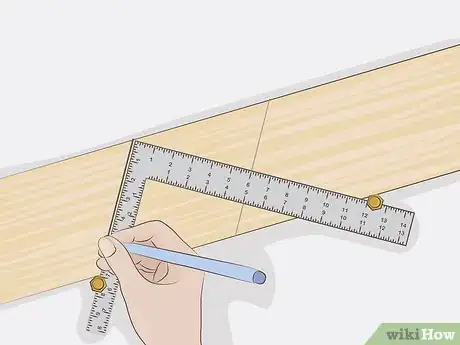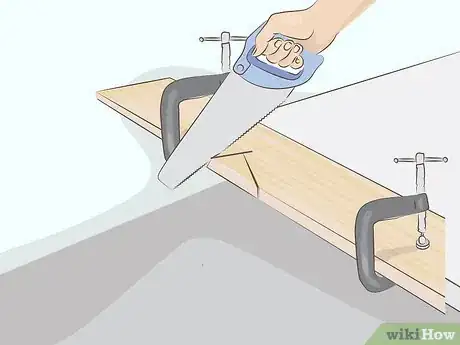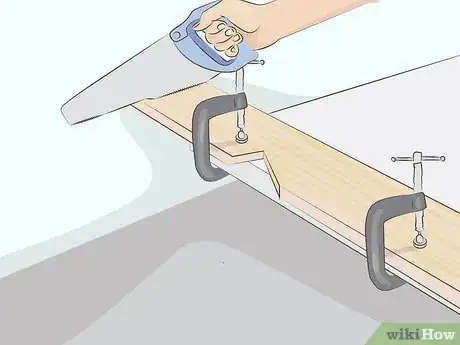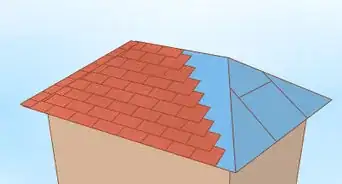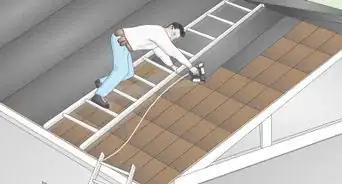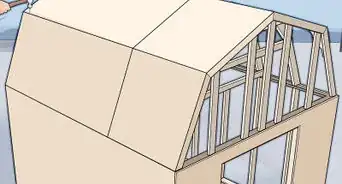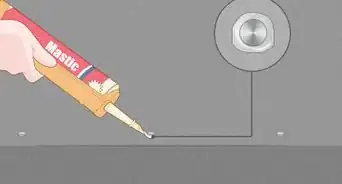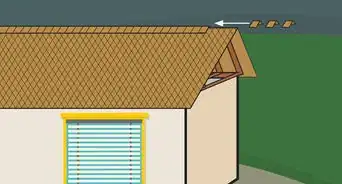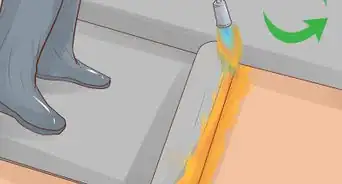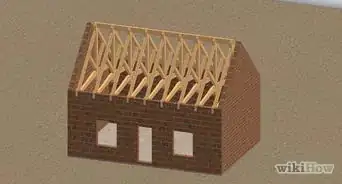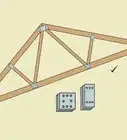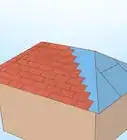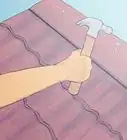This article was co-authored by wikiHow Staff. Our trained team of editors and researchers validate articles for accuracy and comprehensiveness. wikiHow's Content Management Team carefully monitors the work from our editorial staff to ensure that each article is backed by trusted research and meets our high quality standards.
There are 16 references cited in this article, which can be found at the bottom of the page.
This article has been viewed 442,447 times.
Learn more...
If you’re framing a gable roof on a new house, or building a shed or even a doghouse with a gable roof, you’ll need to cut a number of roof rafters. The roof rafters provide integral structural support to the roof. Before you cut your boards, you’ll need to measure the width of your building and calculate the exact length of each rafter. When you cut the rafters, you’ll need to make 3 separate cuts: the ridge cut (also called the plumb cut) at the top of the rafter, the birdsmouth cut (which itself comprises 2 different cuts) where the rafter meets the building’s wall, and the tail cut, at the base of the rafter.
Things You Should Know
- Take measurements of your roof and plug them into a roofing calculator to figure out the length of each rafter.
- Make a plumb cut along the top of your rafter with a framing square and a circular saw.
- Calculate and mark where the birdsmouth and tail cuts need to go. Birdsmouth cuts go on top of the building's wall, and the tail cut goes at the bottom of the rafter.
- Saw through your pre-marked lines to make your birdsmouth and tail cuts.
Steps
Calculating Rafter Length
-
1Measure the width of your building. Before you start cutting, you first need to determine how long your roof rafters need to be, and the angles at which you’ll cut the top and bottom of the rafter. Use a tape measure to measure the entire width of your building. Measure as precisely as possible, down to the 1⁄4 inch (0.64 cm), 1⁄8 inch (0.32 cm) , or 1⁄16 inch (0.16 cm) .[1]
- For example, the width of the building may be 72.75 inches (184.8 cm).
- Use a pencil to jot the width down somewhere. Write on a spare sheet of paper or a section of exposed wood.
- Making these measurements 2 or 3 times is a good way to ensure accuracy.
-
2Subtract the width of your ridge beam. The ridge beam is the vertical piece of plywood which will form the peak of the gable, and to which you’ll fasten the rafters on either sides. Measure the width of the ridge beam: if you’re using a 2x4, it’ll measure 1.5 inches (3.8 cm). Subtract this measurement from the width of your building.[2]
- So the new width measurement will be 71.25 inches (181.0 cm). Jot down this “adjusted” width measurement as well.
Advertisement -
3Divide the adjusted width measurement by 2. Since each individual rafter will only span half of the building’s width (minus the width of the ridge beam), divide the adjusted width measurement in half.[3]
- So, the example halved width measurement will be 36.63 inches (93.0 cm).
- The final measurement is referred to as the “run” of a building. Write the run measurement down alongside the other measurements.
- If you’re using a roofing calculator, press the “Run” button to input the run measurement in the calculator’s memory.
-
4Calculate the roof pitch. The pitch of the roof is a ratio: the number of inches that the roof rises vertically for every foot of roof. This is a way of measuring the degree of steepness of the roof. So, use a tape measure to find the height of the roof above the top wall of the building. Also measure the length of half of the roof from one side of the ridge beam to the edge of the building. If the roof rises 7 inches (18 cm) for every 1 foot (0.30 m), its pitch would be written as 7/12.[4]
- If you’re using a roofing calculator, press the “Pitch” button to input the pitch ratio in the calculator’s memory.
-
5Determine the length of each rafter. If you’re using a roofing calculator, it will use the information you’ve already input (run measurement and pitch) to calculate the length for each rafter. Press the “Diagonal” key, which will calculate the diagonal measurement between your structure’s outside wall and the top of the ridge beam. Write down this diagonal measurement. In this example, it will be 39.81 inches (101.1 cm).[5]
- If you’re not using a roofing calculator, you’ll need to perform some complex trigonometry to calculate the rafter length. You’ll also need to purchase a copy of a roofing ready reckoner: a manual with rafter length tables.
- Roofing calculators are commonly used by professionals. If you’d rather not purchase one, there are many available for free online. For example, there’s a free roofing calculator at: https://www.roofcalc.org/roof-rafter-calculator/.
- Keep in mind that, if you want your rafters to overhang past the edge of the building wall, you’ll need to add that measurement in separately. The calculator (or math equation, if you’re writing it out longhand) will only calculate the diagonal measurement to the edge of the building.
-
6Calculate the rise of your roof. The “rise” is the vertical measurement that indicates how tall the roof will be at its highest point above the walls of the building. The rise is the exact height of the ridge beam.[6] If you’re using a roofing calculator, press “Rise,” and it will calculate the value.[7]
- If you’re not using a roofing calculator, simply subtract the height of your walls from the total height of the roof at its peak.
- The example rise will be 17.81 inches (45.2 cm). Jot down this number alongside the others you’ve already written.
Making the Plumb Cut
-
1Fix stair gauges on the framing square to mark the pitch. So, if the pitch of your roof is 7/12, place one stair gauge on the vertical part of the framing square (the “tongue”) at the 7 inches (18 cm) mark, and place one stair gauge on the horizontal part of the framing square (the “body”) at the 12 inches (30 cm) mark. This will give the framing square the angle you need to make the ridge cut.[8]
- You can purchase both stair gauges and a framing square at your local hardware store.
-
2Mark the plumb cut at the top of the rafter. The plumb (or ridge) cut is made at the top of the rafter. Choose which end of your rafter you want to be the top. Set the framing square on top of the rafter beam, with the tongue facing the top of the rafter. Then, use a pencil to trace the outside edge of the framing square’s tongue.[9]
- Since you’ve attached stair gauges to the framing square, the line you’ve drawn will be at the correct angle for the rafter to lay flat against the ridge beam.
-
3Saw along the line you’ve marked to indicate the plumb cut. Using a handsaw or a circular saw, cut the rafter along the line you’ve just marked. Be sure to follow the line exactly, or you’ll have an uneven plumb cut.[10]
- Clamp the rafter to a workbench or sawhorses before cutting to ensure stability. C-clamps would work well for this.
- If you’re using a handsaw, grasp the handle firmly in your dominant hand. Saw back and forth using the full length of the blade.
Measuring and Marking the Birdsmouth and Tail Cuts
-
1Measure the diagonal of the rafter. Start this measurement from the top (the long end) of the cut you just made. When the rafter is installed, this top/long end will be at the peak of the ridge beam. Hook your tape measure on to the rafter, and measure the diagonal rafter length that you calculated earlier. Use your pencil to mark the length directly on the rafter.[11]
- The diagonal measurement is the full length of the rafter, minus the overhang. Measuring the diagonal will allow you to make the tail and bird's mouth cuts in the correct locations.
- In this example, the diagonal measurement that you found earlier was 39.81 inches (101.1 cm).
-
2Position the framing square to make the birdsmouth cut. Align the framing square so that the stair gauge that you’ve placed on the tongue (short edge) of the framing square is on the pencil mark you made to indicate the full diagonal length of the rafter. Hold the long end of the framing square so that the other stair gauge is also resting against the rafter; this will ensure that you mark the tail cut at the correct angle.[12]
- Use your pencil to trace the full length of the tongue along the width of the rafter.
-
3Determine the depth of the birdsmouth cut. This is relatively simple: measure the full width of the outside wall. For most buildings, the birdsmouth cut is 4 inches (10 cm) deep.[13] The width of the 2x4 used to frame the outer wall measures 3.5 inches (8.9 cm), and the outside sheathing measures 1⁄2 inch (1.3 cm).[14]
- Sheathing is the term used for the board or panel that forms the outer surface of a building.
-
4Position the body of the framing square on the rafter. Use the body (long side) of the framing square. Rotate it 180° from how you’ve been using it (so the right angle is pointing up). Set it so that the 8-inch (20 cm) mark on the body of the framing square intersects the line for the tail cut. This will provide a 4 in (10 cm) birdsmouth cut.[15] Use your pencil to trace this line onto the wood.
- If your bird's mouth cut is not 4 inches (10 cm) deep, slide the framing square to shorten or lengthen the length of the cut accordingly. [16]
-
5Measure the rafter overhang. If, for example, you want the rafter to overhang the edge of your building by 6 inches (15 cm), measure this now. Keep the framing square in the position that it was set in to measure the birdsmouth cut. Slide the framing square until the 6 in (15 cm) mark intersects the line you’ve marked for the birdsmouth cut.[17]
- Overhang is the portion of the rafter that will extend past the edge of the building’s wall. This will lengthen the total length of the rafter by 6 inches (15 cm), bring the new total length to 45.81 inches (116.4 cm).
-
6Trace the tail cut. Keep the framing square in the same position, and use your pencil to trace the tongue (short side) along the surface of the rafter. (The stair gauges will hold the framing square at the proper angle.) This will mark the tail cut: the very end of your rafter, with the 6 inches (15 cm) overhang built in and the birdsmouth cut neatly marked.[18]
- Now all that’s left is to cut the rafter accordingly.
Making the Birdsmouth and Tail Cuts
-
1Saw along the line you marked for the birdsmouth cut. Be very precise with this cut since, unlike the plumb cut, you can’t saw all the way through the board. Carefully follow the lines you’ve marked for the tail cut so that it maintains the specific measurements and angles.[19]
- For added stability when making the birdsmouth and tail cuts, use C-clamps to clamp the rafter to a workbench or sawhorses.
-
2Saw along the line you marked for the tail cut. Using your handsaw or circular saw, cut precisely along the line that you’ve marked for the tail cut. The excess rafter material will fall off as you complete this cut, leaving you with the finished rafter.[20]
-
3Repeat the process for your other rafters. At this point, you’ve cut 1 roof rafter. Depending on the size of your structure, you will need to cut several (or many) more. All roof rafters should be identical, so follow the same steps to measure the plumb cut, tail cut, and birdsmouth cut.[21]
- The number of rafters needed will be determined by the length of your roof. Rafters are commonly spaced about 24 inches (61 cm) apart. Refer to this chart for more detailed rafter-spacing information: https://www.mycarpentry.com/rafter-span-tables.html.
- Keep in mind that you’ll always need an even number of rafters.
Warnings
- Always take safety precautions when working with any type of saw. Keep your hands away from the blade, and wear safety goggles or other protective eyewear.⧼thumbs_response⧽
Things You’ll Need
- Roofing calculator (recommended)
- Tape measure
- Framing square
- Stair gauges
- Pencil
- Safety goggles
- Hand saw or circular saw
References
- ↑ https://www.youtube.com/watch?v=fBxcx6YKz54&feature=youtu.be&t=24s
- ↑ https://www.youtube.com/watch?v=fBxcx6YKz54&feature=youtu.be&t=1m19s
- ↑ https://www.youtube.com/watch?v=fBxcx6YKz54&feature=youtu.be&t=1m47s
- ↑ https://www.pole-barn.info/building-rafters.html
- ↑ https://www.youtube.com/watch?v=fBxcx6YKz54&feature=youtu.be&t=2m24s
- ↑ http://www.thisiscarpentry.com/2012/11/09/common-rafter-framing/
- ↑ https://www.youtube.com/watch?v=fBxcx6YKz54&feature=youtu.be&t=2m37s
- ↑ http://www.thisiscarpentry.com/2012/11/09/common-rafter-framing/
- ↑ https://www.youtube.com/watch?v=fBxcx6YKz54&feature=youtu.be&t=4m4s
- ↑ https://www.youtube.com/watch?v=fBxcx6YKz54&feature=youtu.be&t=4m4s
- ↑ https://www.youtube.com/watch?v=fBxcx6YKz54&feature=youtu.be&t=4m35s
- ↑ http://www.thisiscarpentry.com/2012/11/09/common-rafter-framing/
- ↑ http://www.thisiscarpentry.com/2012/11/09/common-rafter-framing/
- ↑ http://www.harvarddesignmagazine.org/issues/45/nominal-versus-actual-a-history-of-the-2x4
- ↑ https://www.youtube.com/watch?v=fBxcx6YKz54&feature=youtu.be&t=5m28s
- ↑ http://www.thisiscarpentry.com/2012/11/09/common-rafter-framing/
- ↑ https://www.youtube.com/watch?v=fBxcx6YKz54&feature=youtu.be&t=6m1s
- ↑ https://www.youtube.com/watch?v=fBxcx6YKz54&feature=youtu.be&t=6m8s
- ↑ https://www.youtube.com/watch?v=fBxcx6YKz54&feature=youtu.be&t=6m48s
- ↑ https://www.youtube.com/watch?v=fBxcx6YKz54&feature=youtu.be&t=7m2s
- ↑ https://www.youtube.com/watch?v=fBxcx6YKz54&feature=youtu.be&t=7m18s
About This Article
To cut roof rafters, start by fixing the stair gauges on your framing square to the dimensions of your pitch. Next, set the framing square on top of the rafter beam and use a pencil to trace the outside edge of the framing square’s tongue. Once you’ve marked the lines, use your pencil to draw the diagonal length on the rafter. Then, reposition your framing square so that the stair gauge of the tongue is on the pencil mark you made to indicate the full diagonal length of the rafter. Make sure the other stair gauge is resting against the rafter and use your pencil to trace the length of the tongue. After you’ve done that, rotate your framing square 180 degrees so that the 8-inch mark on the long side of the framing square intersects the line for the tail cut. Then, trace the short side of the framing square with a pencil to mark the tail cut. Finally, use a handsaw or circular saw to cut along the plumb cut, birdsmouth, and tail cut lines. For more tips, including how to calculate your rafter length, read on!

